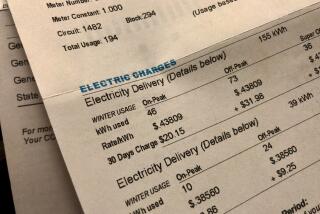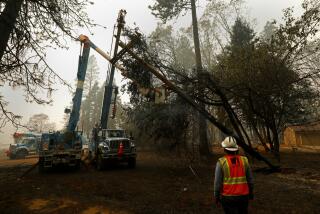Pacific Enterprises Peddles Plan to Restore Dividend
- Share via
Shareholders of Pacific Enterprises, parent of Southern California Gas, will soon earn a cash dividend again. Though it won’t be anywhere near the old $3.48-a-share yearly rate, the attraction in Pacific’s new dividend is that it seems likely to rise briskly for several years.
That could make this stock an interesting capital gains play for a while--along the lines of what happened with other once-troubled utilities such as General Public Utilities and Northern Illinois Gas parent NICOR Inc.
Pacific’s stock, which crashed from $52 in 1990 to $17.375 last year as the company’s disastrous diversification program unraveled, has since rebounded to $24.25 on the New York Stock Exchange as of Thursday. The stock has risen from $21 just since the end of February.
Next Wednesday and Thursday, Pacific CEO Willis B. Wood Jr. will take his turnaround game plan to Wall Street--the first presentation by Pacific to New York securities analysts in nearly three years. The road show is likely to further boost investor interest in the stock.
Wood’s plan is pretty simple: Pacific is back to being a steadily profitable natural gas utility, period. Gone are previous management’s ill-fated forays into retailing (Thrifty Drug and Big 5 Sporting Goods) and oil exploration--ventures that cost Pacific $668 million in write-offs last year when they were jettisoned.
They cost shareholders a lot more: Rising red ink forced the firm to slash the annual dividend on this former “widows-and-orphans” stock from $3.48 a share in 1990 to $1.76 in 1991. Last year, the payout was eliminated entirely, a severe blow to older investors who depended on that income.
*
Now Wood says that restoring the dividend is a “top priority” for 1993. Many analysts expect a payout to resume by June. The only holdup is Pacific’s need to retire about $225 million of debt left over from its diversification craze. To help ax that debt, Pacific plans to issue new common stock this spring, probably about 6 million shares.
The key question, of course, is how big a dividend will Pacific pay? Wood won’t yet say exactly what he’ll recommend to Pacific’s board. Wall Street analysts figure the annual payout could be anywhere from 80 cents a share to $1.20 a share, with $1 seen as the most likely figure.
Here’s how analysts arrive at their numbers:
Wood tells shareholders in the firm’s 1993 annual report that Pacific’s restored dividend will represent a percentage of earnings “somewhat below current levels for non-diversified natural gas distribution utilities, but in line with historical payouts of that group.”
As the accompanying chart shows, many of Pacific’s utility peers in other parts of the country pay out 85% or more of their net earnings per share. But historically, the dividend payout for these companies runs between 65% and 80%.
Assuming Pacific meets earnings expectations of about $1.70 a share this year (after accounting for the dilutive effect of the stock offering), a 70% payout would mean an annual dividend of $1.20.
But many analysts believe Pacific will go with a smaller dividend--around $1--to present an image of conservatism. That would sit a lot better with creditors and regulators still wary after the company’s diversification debacle.
*
A $1-a-share dividend would yield 4.1% at the stock’s current price of $24.25. While that would be below the yields available on most other gas utilities, Pacific would have an advantage over its peers: A lower payout ratio would give Pacific more leeway to raise its dividend faster than its peers raise theirs over the next few years.
“My sense is that they should start lower, then accelerate the payout rate,” says Dan Tulis, gas utilities analyst with Smith Barney, Harris Upham & Co. in New York.
That, in turn, should make the stock appealing to investors who want both dividend income and capital gains potential in a utility stock: If Pacific can raise its dividend even 6% a year for a few years, that would be double or more the 2% to 3% increases that most gas companies can afford.
That strategy of starting low on the dividend and raising it at a fast pace has been employed by other recovering utilities since the mid-1980s, with good results for their stocks. Analyst Doug Christopher at Crowell, Weedon & Co. in Los Angeles believes Pacific stock could hit $30 in 24 months, as investors bid it up on expected dividend hikes.
Even $30 a share wouldn’t mean much to longtime shareholders who may have paid $50 or more. But for new investors looking for decent income plus appreciation potential, Pacific is again an intriguing idea.
Gas Utilities: Big Payouts Pacific Enterprises, parent of Southern California Gas, has pledged to restore its dividend soon--but probably not to the levels its peers pay. Here are dividend yields and payouts (dividends as a percentage of earnings) for seven big gas companies.
Stock Div. Div. Stock price yield payout Atlanta Gas 42 1/8 4.9% 92% Brooklyn Union 40 3/8 4.9% 92% Indiana Energy 33 5/8 4.4% 85% NICOR 57 5/8 4.2% 64% Peoples Energy 31 1/8 5.7% 86% Southwest Gas 17 1/2 4.0% 86% Wash. Gas Light 42 7/8 5.0% 85%
All trade on NYSE.
More to Read
Inside the business of entertainment
The Wide Shot brings you news, analysis and insights on everything from streaming wars to production — and what it all means for the future.
You may occasionally receive promotional content from the Los Angeles Times.










